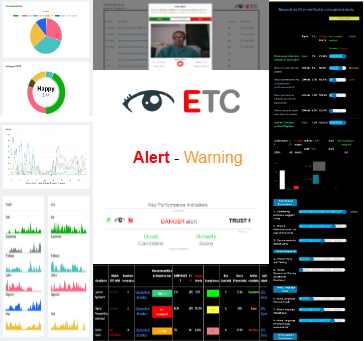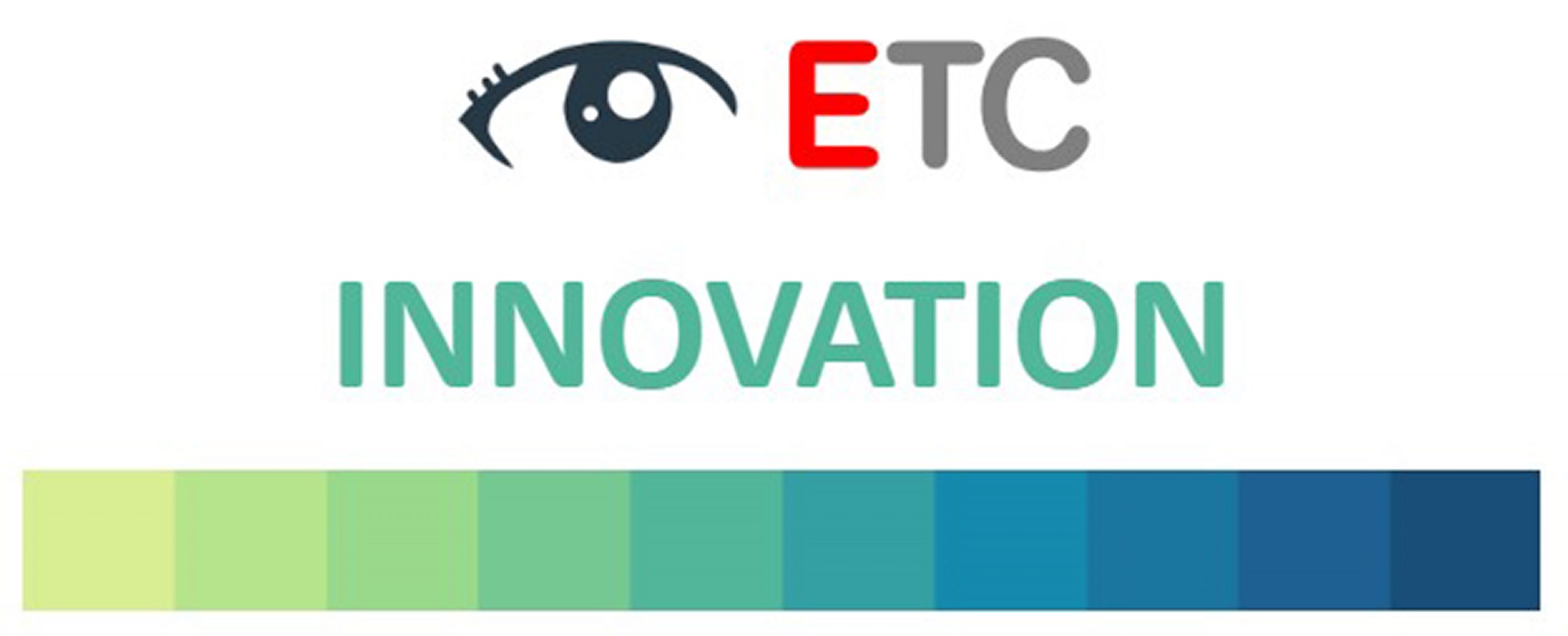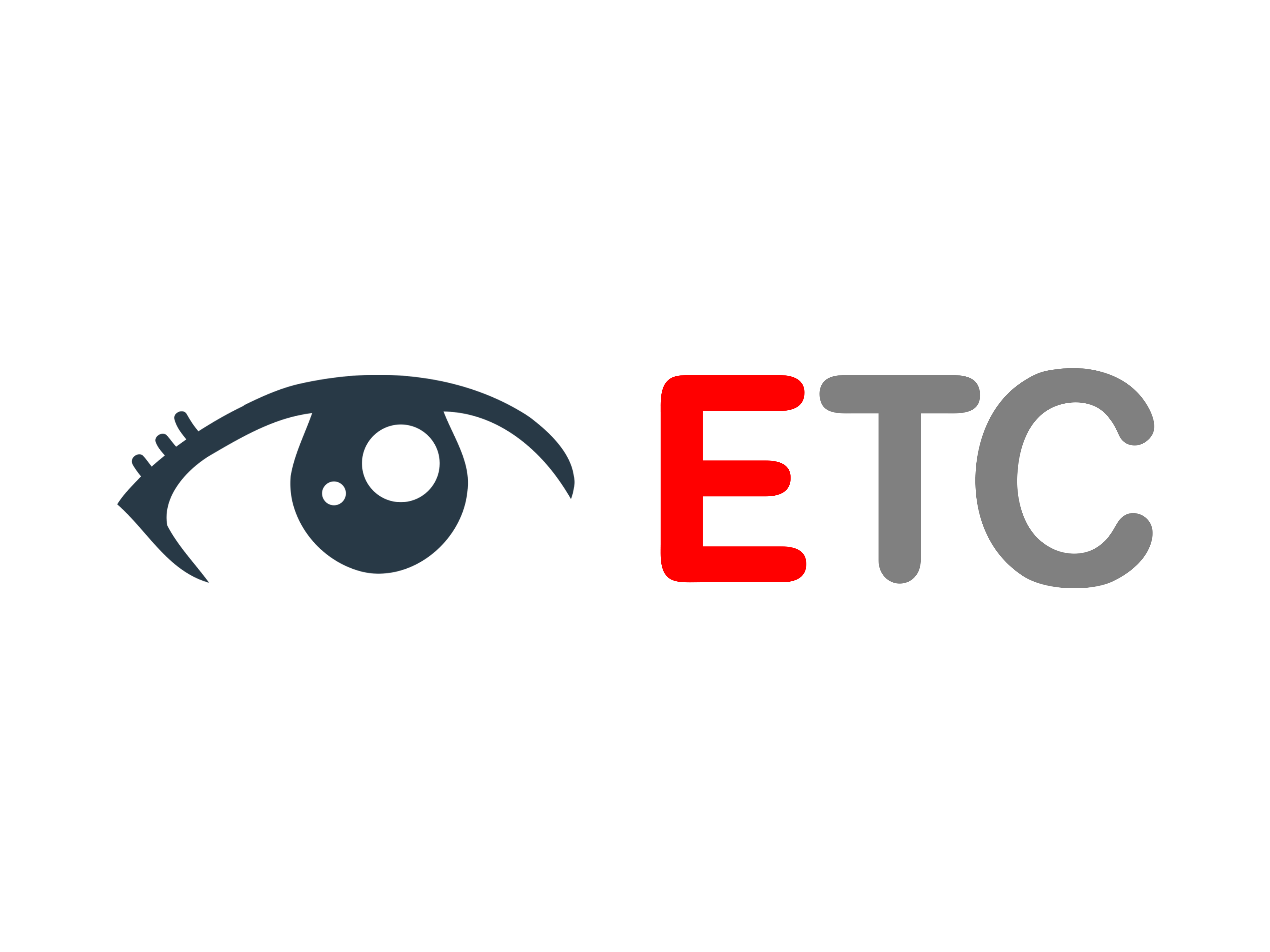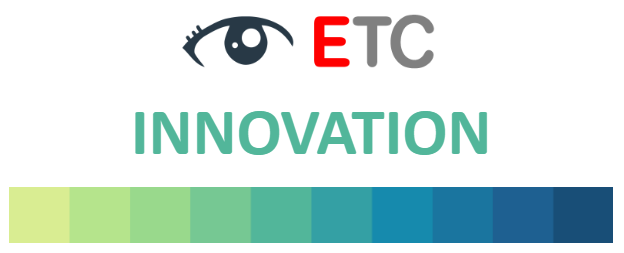ETC Innovation as a mindset, not a project!
ETC AI Innovation Definition: The introduction of something new and valuable
Subject area: The EMOTIONAL Fingerprint™ of a group of employees to diagnose and improve Innovation that deliver results.
By asking your employee-volunteers the right questions, extracting & accumulating scientific results over time, you can diagnose and measure the evolution of Innovation.
Innovation Success is a Journey, not a destination!
Innovation Critical Issues
-
Assess Capabilities – Global R&D
-
A Lateral Thinking vs Logical Mind
-
Brainstorming & Daydreaming
-
Burnout & Stress
-
Challenge & Rewards
-
Comfort Zone & Personal Growth
-
Creativity & Criticism (Devil´s Advocate)
-
Diversity & Discrimination
-
Employee Engagement
-
Entrepreneur Mindset
-
3 P´s = Passion, Perseverance, and Positivity
-
Evolving Landscape – Competition & Threats
-
Free Thinking & Ideas Generation
-
Physical & Mental Health (eat right & exercise)
-
Ideas Sources & Generation Process
-
Immersion (do it yourself)
-
Innovation Culture & Multinational Mix
-
Innovation Metrics & Financial Performance
-
Innovation Teams & Healthy Conflict
-
IT & AI (state-of-the-art Tech) possibilities
-
Leadership Vision
-
Management Commitment to Innovation
-
Meditation & Mindfulness
-
Observe Customer Behavior (needs)
-
Suppliers & Consultants Integration
-
Universe of Possibilities
-
Viable Prototype (business, product, service, process)
Business Event
The Employees have a permanent interaction with ideas, customers and processes, they receive valuable information that is not easily processed. The ETC interview process allows us to extract and calculate emotional variations expressed in questions from the Innovation Critical Issues and diagnose the current situation.
Lateral thinking is the ability to use your imagination to look at a problem in a fresh way and come up with a new solution.
Lateral thinking and processes are becoming strategically important in empowering teams to create the disruptive concepts companies need to stay competitive.
It usually takes less than six months to create an innovative solution, but on average 5 years to be recognized as an innovation in the market.
Actors & Roles
(CM) – Company Innovation Team – Responsible of ETC Performance Project in the client side.
(SP) – Staff & Management – Organization Employee.
(EP) – ETC Partner – Expert Consultant to Coordinate the Process.
(EX) – Examiner – Scores the manually the Good Employee/Candidate.
(OB) – Observer – Quality Assurance.
(EE) – ETC Experts – Worldwide field specialits (AI-Predictive Models, R&D, GDPR, Security, etc.)

ETC Performance Diagnose Method
a. CM & EP – Define the Innovation critical issues to Observe, Diagnose & Improve (Scope & Approach). Data & Metrics that support the current situation.
b. CM & EP – Generate relevant questions per each Critical Issue to be measured and expected improved results.
c. EP – Setup the ETC Employee & Corp Scan solution to perform interviews.
d. CM & EP – Select a Staff or Management segment and frequency to initiate interviews.
e. SP – Employees perform the Video Recording interviews.
f. EP – Critical Issues Data Collection to Diagnose the severity of each Critical Issue and generate a Report over findings.
g. EE – Perform Predictive Modeling (machine learing).
h. CM & EP – Integrate Strategies & Work Plans to Improve.
i. CM, EX & EP – Adjust Questions to fine-tune and confirm trends & patterns.
i. EX, EP & EE – Evaluate and Present to the client the Results.

Innovation Strategy & Metrics (Predictive Models Correlation)
Record Data Entry Values (Diagnose) and Evolution over the project (Improve).
It usually takes less than six months to create an innovative solution, but on average 5 years to be recognized as an innovation in the market.
Assemble an innovation team and establish an innovation culture. Research and experience have shown that a highly diverse team will always beat a team of specialists.

ETC Performance Consulting – Output Summary
ETC AI generates the EMOTIONAL Fingerprint® at different dimensions and levels, Employees to improve their performance the Corp Climate, Critical Issues, and the organization’s Innovation as a team.
Innovation Team & Culture
Form an innovative team and build an innovative culture. Research and experience show that highly diverse teams always beat tradictional and professional teams.
What is the right size for your innovation team?
First, more is not necessarily better. Building a large team can backfire and prohibit clear and effective communication and collaboration.
Finding the right crowd is more important. So don’t get obsessed with job titles and descriptions. Instead, focus on individual skills and diversity as you build your dream team.
Second, keep in mind that while specific roles are necessary, there’s no reason why one person can’t fill more than one role. Again, keeping this in mind helps build a more minor, agile team.
4 key roles for Innovation Teams
Expert recruitment
This person will connect with external sources, build relationships with companies like ETC-AI, and explore new verticals. Depending on your industry, recruiters may also want to reach out to clients to gather information and seek their help as a potential source of innovative ideas.
Innovation Champion/Corporate Liaison
Transparency can play an essential role in enabling the rest of the company to adopt new ideas and processes early. Innovation teams should share their work and even seek input from other company members to make the innovation process more inclusive.
Once a new process and product are formally introduced into the workforce, making it a priority and assigning a team member to start informal conversations throughout the process can go a long way.
State-of-the-Art Technology Expert
Successful innovation relies heavily on leveraging the latest tools and technologies. Technicians can master ideas and plans for collaboration and help introduce new technologies to teams.
This person tends to convey a more data-driven perspective, which helps provide a valuable framework to assess an idea’s viability objectively.
Product Expert
Setting goals and planning new paths starts with understanding the current state of your business and market. Product specialists must understand competition, emerging trends, potential growth opportunities, and their existing products.
Innovation Culture
Do we clearly understand the origin of the problems?
Innovation is the key to a successful and growing business, and your employees must constantly look for ways to increase their revenue. As a leader, it is your responsibility to help keep your employees engaged and motivated to create what is best for the company.
To help your employees in the innovation process, we asked the experts for ways to spark more profound thinking. Likewise, leaders must motivate employees to generate ideas and solutions to their most challenging problems.
What do you think about a critical issue?
C-level executives love to complain that no one comes up with good ideas, but they rarely ask their employees what they think. Groupthink is a real challenge, especially when the founding partners are leading the change. They must be open to change and ideas from their team; You might be surprised what can come out. But, on the other hand, leaders need to get out of the way sometimes; maybe their vacation period is a good time.
What makes you happiest in the company?
This may seem like a simple question, but it opens the doors to understanding your employees and giving them the tools to do work that inspires and satisfies them. The answers to this question will direct you to the next step. For some employees, a better office environment will encourage them to do a better job. For others, it may be a clear vision.
What would you do if you were the leader of your area?
Placing employees in a higher position of authority opens their minds to think of new solutions and creative possibilities. It’s easier to think outside the box when you have no limits, and being the leader gives them more options.
What things would you like to change?
“If you were running the company, what would you change?” This empowers the employee, encourages them to think creatively, and does not limit them to one idea or solution. Ask regularly over time, as the answer to this question will change as your business grows and develops.
What is going well in the company?
Ask team members for success stories on the job. Ask them, “What small accomplishments did you have this month?” This is a great way to determine if your team has what it takes to succeed, see how projects are going, and make sure they feel their small wins are just as important as their top priority. They will feel valued and inspired to keep working hard, being creative, and striving for results.
How am I executing my work as a leader?
Managers must be used to providing feedback to their direct reports but often forget to receive feedback on how they are performing as leaders. So you have to ask your team, “How am I doing?” or “Do you have any feedback on a critical issue?” Feedback on your performance as a leader will help you see things differently, which may lead to new ideas or solutions.
How would you like a company to market to you as a consumer?
When you put yourself in the customer’s position, it’s easier to understand what they want and how they want to market it. This is a practical question because it focuses on maximizing conversions and putting them on the customer, which is the best way to ensure they get what they want.

Disruptive Innovator Skills
Analytical skills
it’s a simple truth that you won’t advance very far in banking and finance unless you possess the analytical skills to identify trends, patterns, and definitive conclusions from the data you’ll have exposure to.
Commercial awareness
With the ability to anticipate financial trends and future business developments in the corporate world, it’s also necessary to understand how businesses operate and what drives them, mainly if you are working directly with them. While working with a client in a particular industry, you need to understand anything about that industry’s climate, risks, and potential change factors.
Attention to detail
An educated eye for detail is another requisite for banking, whether noticing particular trends or activities that nobody else has or producing complex financial reports for senior management.
Determination
The banking industry is a ruthless and very competitive environment, where you’ll have to overcome many obstacles on your journey from wide-eyed intern to seasoned account manager.
Work ethic
Banking is not for the lazy or the unmotivated. It is no secret that bankers work long hours. Indeed, junior bankers at top Financial Institutions work extended hours, leading to extreme burnout and high-stress levels.
Confidence
The general perception of the industry is that you need to be confident to succeed.
Technical skills
As with most industries in the digital age, most of the decisions you make will be based on data analysis. Therefore, you’ll need to be tech-savvy to access and process that data, communicate, and perform well.
Bankers work with specialized software, so take every opportunity during internships or placements.

Performance Consulting Deliverables and Benefits
-
“Cultural Risk” report based on the countries where the company operates.
-
Reports of each Employee and Candidates included the Examiner’s evaluation.
-
Diagnosis of the Innovation Critical Issues (Opportunities for Improvement) presented quarterly.
-
Detailed Action Plan and follow-up with ETC and company metrics, as well as job performance to correlate variables that increase profits.
Benefits: Substantial improvement of the Organizational Climate, Critical Issues improvement, and at least XX% increase in profits at the end of the project.
Innovation methodologies
Refers to the process or framework that a company or organization uses to generate and develop new ideas or solutions to problems. There are many different approaches to innovation methodology, and the best one for a given organization will depend on its goals, resources, and industry.
Here are a few common approaches to innovation methodology:
Design thinking: This approach focuses on understanding the needs and perspectives of the end user and using that understanding to design solutions that meet those needs.
Lean startup: This approach emphasizes the importance of experimentation and rapid prototyping in the innovation process. It encourages organizations to quickly test ideas and iterate on them based on customer feedback.
Agile development: This approach is commonly used in software development and involves breaking a project down into smaller, iterative cycles and continuously refining and improving upon the product as it is being developed.
Problem-based learning: This approach involves identifying a specific problem or challenge and working to develop a solution through a process of investigation and experimentation.
Regardless of the approach used, a successful innovation methodology should encourage collaboration, encourage experimentation, and provide a structured process for evaluating and implementing new ideas.
The design thinking innovation method typically follows a five-step process known as the “design thinking loop“:
Empathize: In this step, you seek to understand the needs, desires, and motivations of the end user by conducting volunteer questionnaires and gathering Emotional Fingerprint feedback.
Define: Based on the critical issues gathered in the empathize step, you define the problem or challenge that needs to be addressed.
Ideate: In this step, you generate as many ideas as possible for potential solutions to the problem. This can be done through techniques such as brainstorming or sketching.
Prototype: From the ideas generated in the ideate step, you select the most promising ones and create prototypes to test and refine.
Test: You gather feedback on the prototypes and use it to iterate and improve upon the designs until you have a final solution that meets the end user’s needs.
This process is meant to be iterative and flexible, with the idea that you will go back and forth between the different steps as needed until you arrive at a successful solution. It is also essential to involve a diverse group of people with different perspectives and skills to ensure that a wide range of ideas is generated and considered.
The lean startup innovation method is a framework for developing and testing new business ideas that emphasizes the importance of experimentation and rapid prototyping.
It was developed by entrepreneur and author Eric Ries and is based on the idea that startups (and other organizations) can use a scientific, data-driven approach to innovation.
The lean startup approach follows these key principles:
Build-measure-learn feedback loop: This is the core of the lean startup approach and involves building a minimal viable product (MVP), measuring how customers respond to it, and using that feedback to learn and improve upon the product. This process is repeated until the product meets the needs of the customer.
Validated learning: The lean startup approach emphasizes the importance of gathering empirical data to validate or invalidate assumptions about the product and its potential market.
Rapid experimentation: The lean startup approach encourages organizations to quickly test and iterate on ideas in order to learn and improve as quickly as possible.
Customer focus: The lean startup approach prioritizes the needs and desires of the end customer and encourages organizations to gather customer feedback and use it to guide product development.
The lean startup approach can be applied to a variety of industries and is particularly well-suited for startups that are looking to quickly test and validate new ideas with a minimal investment of time and resources.
Agile development is a project management approach commonly used in software development but can also be applied to other types of projects.
It is based on the Agile Manifesto, a set of principles that prioritize flexibility, collaboration, and continuous improvement in the development process.
The Agile development approach follows these key principles:
Prioritize people and interactions over processes and tools: Agile development emphasizes the importance of collaboration and communication among team members.
Prioritize working software over comprehensive documentation: Agile development focuses on delivering functional software as quickly as possible rather than spending much time on upfront planning and documentation.
Continuous delivery of working software: Agile development encourages organizations to break a project down into smaller, iterative cycles and continuously deliver and improve upon the product as it is being developed.
Measure progress through working software: Agile development uses the software developed to measure the project’s overall progress.
Adaptive planning, evolutionary development, and delivery: Agile development encourages organizations to be flexible and adaptable in their planning and development process and to improve upon the product as it is being developed continuously.
Agile development is a popular approach in software development because it allows teams to respond quickly to changing requirements and customer needs and encourages collaboration and continuous improvement.
Problem-based learning (PBL) is a teaching and learning approach that involves students working in small groups to solve real-world problems or challenges.
It is based on the idea that students learn best by actively engaging with and applying their knowledge to solve problems rather than passively receiving information.
The PBL process typically follows these steps:
Identify a problem or challenge: The problem should be authentic, complex, and relevant to the students.
Research the problem: Students gather information and resources to better understand the problem and its context.
Develop a plan to solve the problem: Students work together to develop a plan for solving the problem, including identifying necessary resources or skills.
Implement the plan: Students implement their plan and work to solve the problem.
Reflect on the process: After the problem is solved, students reflect on the process they used and learned from.
PBL can effectively engage students and promote deep learning, as it encourages critical thinking, problem-solving, collaboration, and self-directed learning. It is often used in higher education but can also be applied in other settings, such as corporate training and innovation processes.

ETC Innovation sprints
Are a structured process for quickly prototyping and testing new ideas or solutions to problems. They are often used to foster creativity and innovation within an organization and can be an effective way to explore new directions or solve complex challenges.
An ETC innovation sprint typically involves a small team working intensely for a short period of time (often one week) to generate and evaluate new ideas. The team may use techniques such as design thinking or lean startup methodologies to rapidly prototype and test ideas, gathering feedback and refining the concept as they go.
The goal of an innovation sprint is to identify and validate new ideas that have the potential to drive significant value for the organization. Innovation sprints can be used to develop new products or services, improve existing ones, or explore new business models. They are often used in conjunction with agile development methodologies and can help organizations move quickly and adapt to changing market conditions.



